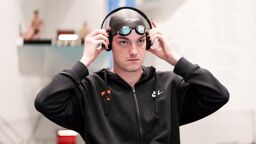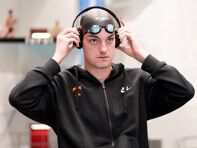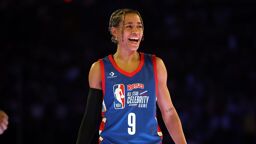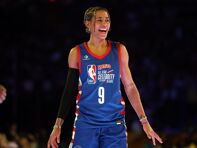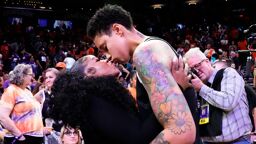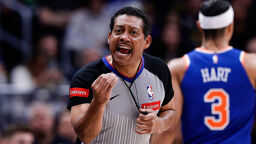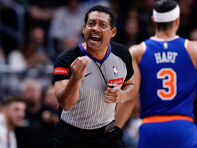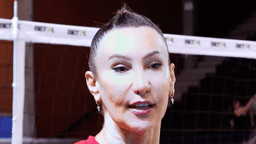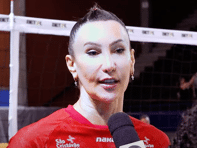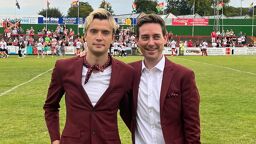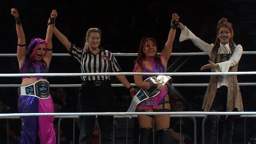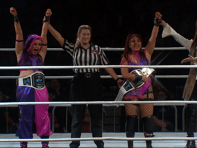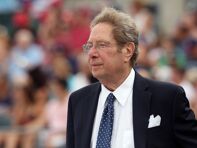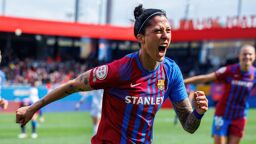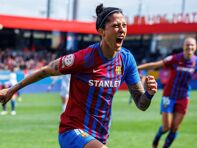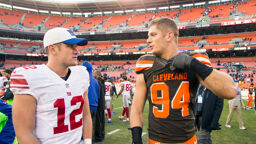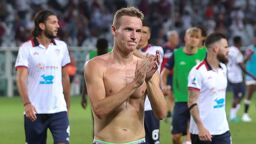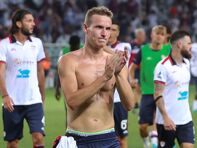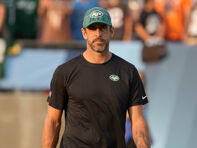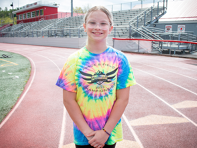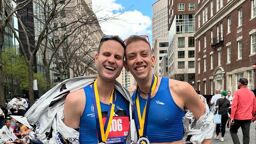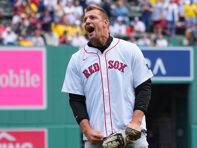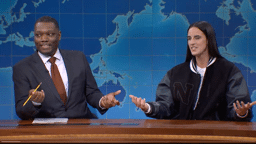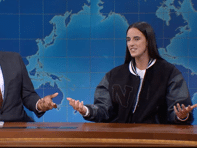(This story was published in 2001).
By: Kay Hawes
Reprinted by permission of The NCAA News
It’s difficult to imagine any issue in intercollegiate athletics that is more taboo than homophobia.
Unlike racism or sexism, homophobia in sports is not an issue where you find high-profile athletes, coaches or politicians willing to take a public stand and call for change.
Even the average athletics administrator and the average student-athlete are reluctant to talk about homophobia — publicly or privately — for fear of having their name associated with homosexuality in some way.
“H” has become the scarlet letter of sports, to be avoided at all costs. Even in 2001, it can ruin your career to be called a homosexual. And because it is such a secret issue, there is no “proving” you are not gay. All it takes is a couple of rumors and some innuendo or assumptions.
But it has become clear that not talking about homophobia is the same as saying it is OK to allow name-calling, threats and incidents of physical harm, and outright discrimination in hiring, promotions or playing time.
There also is a misconception that homophobia is a “women’s issue” in sports. It certainly is not, as several openly gay men in athletics have emphasized.
But it is an issue of student-athlete welfare, and the NCAA Committee on Women’s Athletics has recognized it as such. It is time, the committee says, for the Association to create a safer environment in which student-athletes and athletics administrators are not harassed, are not threatened and are not subjected to anti-gay slurs on the playing field and in the locker room.
Suffering in silence
What exactly is homophobia? It is the irrational hatred or fear of homosexuals, and it manifests itself in a variety of ways.
It is a coach calling a team of men “wussies or fags” or worse, thinking that men will run faster to escape the slurs. It is an athletics director asking all of the female candidates for a coaching job whether they are married — and assuming they are gay and therefore undesirable if they are not.
It is the parents of a prospective student-athlete being told that, “No, we don’t allow any lesbians on our teams here at State.” It is a recruiter from another school telling a high-school student that “you don’t want to go play on that team. It’s full of dykes.” It is a track coach who has coached Olympians being passed over for a job in favor of one of his students — as soon as the search committee found out he was gay.
If even a few student-athletes or athletics administrators were subject to harassment and discriminatory treatment, that would be terrible, but the problem is much bigger than that, said Laurie Priest, an openly gay athletics director at Mount Holyoke College.
“Statistics say that about 10 percent of the population is gay or lesbian,” she said. “So it’s many more people than we realize. People who are gay and lesbian are suffering in silence, and so are people who are not gay but are terrified of being labeled gay if they acknowledge that homophobia is a problem.”
Michael S. Muska, an openly gay athletics director at Oberlin College, agreed. “The reality is that gay student-athletes and administrators are there, but they are afraid to come out,” he said.
“Athletics has been that last bastion of homophobia. It’s one of the few places left where homophobia is tolerated. I think we have a responsibility to see to it that every student-athlete in our programs can feel safe and respected. And the reality is that for many of our gay, lesbian and bisexual athletes, it is not safe in intercollegiate athletics.”
Added Priest, “For so many of my colleagues, homophobia has impacted their careers and even, in some cases, caused them to leave athletics altogether. If we don’t address this issue in intercollegiate athletics, we’re really missing the boat.”
Priest said that homophobia cuts across race, gender and class lines. She said she recently became aware of a black male football player who left college competition because of the harassment he had experienced.
Priest also noted that reports of violence directed against lesbians, gay men, bisexuals and transgendered people have increased each year since the National Gay and Lesbian Task Force has been keeping records.
Student-athletes coming off the field have been called names by fans and opponents, and there have been incidents of harassment, vandalizing of lockers and even physical abuse.
At the NCAA Foundation Leadership Conference last summer, groups of student-athletes discussed the issue of homophobia in athletics. Several of the student-athletes mentioned it as a concern on their campus that had directly affected their team or someone they knew. Many of the student-athletes said that hostility toward gays and language demeaning to gays was routinely seen on their campuses.
Other student-athletes had experienced name calling, just because they played certain sports that had been identified as “gay” on their campus.
“All of the softball players are routinely called dykes, even by other student-athletes at our school,” said one student-athlete. “I have a friend on that team, and it bothers her a lot because her sister is gay. But you don’t dare question that kind of behavior, because then you get called ‘gay,’ too.”
Student-athletes reported incidents of some coaches telling student-athletes that “no gays are allowed” on their teams and also of being told in recruiting not to attend a certain school because of the “number of lesbians” there.
Priest said it is time to address the issue from a student-athlete welfare perspective.
“For the last several years, the NCAA has talked about our concern regarding creating a safe and supportive environment for student-athletes,” Priest said. “We’ve talked a lot about student-athlete welfare, yet we have continued to ignore the welfare of our gay and lesbian student-athletes.”
A history of homophobia
Eric Anderson, an openly gay track and field coach at Irvine Valley College and a lecturer in the sociology of sport and sport psychology at California State University, Long Beach, and the University of California, Irvine, has conducted what is believed to be the first academic research conducted on openly gay athletes, a large number of whom were college athletes.
Anderson, who is pursuing his doctorate, was not surprised to find that a homophobic atmosphere exists in athletics, though each gay person’s experience was different.
“Athletics is a breeding ground for homophobia,” he said, noting that the history of homophobia goes all the way back through the history of sport.
“We have used sport to ‘turn boys into men,’ and that has traditionally meant that a ‘real man’ should be everything that’s the opposite of what it meant to be a woman,” Anderson said, noting that “a real man” was expected to be strong, rugged, independent and a conqueror of women.
“And then, as homosexuality was demonized, anti-gay and anti-woman attitudes have been used as a motivator for young boys in sport,” he said. “And, the way we learn to coach is by modeling the way we were coached. What better way to motivate young men than to call their masculinity into question?” Anderson said. ” ‘Fag’ — it is the standard insult. That kind of language remains unchecked today. What bothers me is that coaches use it themselves. Not all coaches do, but so many do that it’s amazingly present. Even once athletes come out of the closet they are likely to hear it.”
Pat Griffin, author of “Strong Women, Deep Closets: Lesbians and Homophobia in Sport,” points out that sport as an institution has been used to maintain gender roles. An openly gay professor of social justice education at the University of Massachusetts, Amherst, Griffin also is a former swim coach and a former student-athlete who participated in basketball, field hockey and swimming at the University of Maryland, College Park.
“As an institution, sport serves important social functions in supporting conventional social values,” she said. “Historically, sport has been the domain of men. It’s been a training ground where boys learn about being men and being manly. And women who were interested in sport have always had to combat that.
“First, there were concerns about the frail female ‘constitution.’ Then, as women proved that was not a real concern, the focus shifted more to sociological concerns. That happened about the time when people were becoming aware that there was such a thing as women who loved women. Those people were seen as a threat. It became an epithet to call someone a lesbian or a ‘mannish’ woman, which was the same thing.
“The idea was to preserve sport as something just for men. Now, we’ve certainly come a long way since then, but there’s a remnant that remains today.”
Successful women athletes must be careful not to be too “mannish” and to present themselves as feminine, otherwise they are assumed to be lesbian. That was the case back in Babe Didrickson’s day, and it’s still true today, Griffin said.
“Women in sport have come up with all kinds of markers to try to distinguish themselves as heterosexual,” Griffin said, noting that one that has become pervasive is the ponytail. “They do that because they feel pressure, regardless of their sexuality, to ‘prove’ that they are not lesbian.”
Private lives, public lives
One of the reasons often given for not discussing homophobia and homosexuality in sport is that sexual orientation is a “private matter.”
“Homophobia is not a private thing; it’s an abundant and problematic public problem,” Anderson said. “It seems politically correct to say, ‘Isn’t sexual orientation personal?’ That is the most obvious bunch of hogwash. The talk in the locker room among guys is very personal.
“If we were to say that sexual orientation was truly a personal and private matter, we’d need the heterosexual coaches to take all of their photos of their family off of their desks. No more mentioning the wife and children in the media guide. No more showing their children. And of course, that’s ridiculous. It’s dehumanizing. And it’s exactly what they want gay and lesbian athletes and administrators to do. That’s what ‘don’t ask, don’t tell’ really is.”
Anderson also said that if a married coach mentioned his wife in the course of a conversation, no one would think anything of it. But if a gay coach mentioned his boyfriend, that would become the focus of the conversation.
“What straight student-athletes could say or do regarding their relationships is considered ‘in your face’ and ‘personal’ if a gay student-athlete says or does it,” Anderson said.
Priest agreed, and noted that the environment of athletics, with its extensive time demands on both student-athletes and coaches, also makes it a difficult place to keep personal lives private.
“A typical week (for a coach or administrator in athletics) is 60 to 70 hours and often much more. It would be much easier to compartmentalize a 9-to-5 job than it is coaching or administration. For this reason, it is difficult to totally separate your personal life from your professional life,” Priest said.
Priest also said that it is common to see a male heterosexual coach whose wife and children attend every game, lending moral support. For the gay and lesbian coaches, it may be possible at some institutions for a “friend” or “roommate” to attend a few games, but that’s about it.
“There is a fear that if the ‘friend’ attends too many games, people will figure it all out,” she said. “When you work in a job where you have to hide your true identity, you technically cut off an important piece of who you are, and eventually it takes its toll, particularly when the work is intense and the hours are long.”
Griffin agreed and said that a double standard exists for gay student-athletes and administrators.
“We assume it’s normal for a heterosexual person to have a picture of their spouse or family on their desks and to talk about what they are doing over the weekend,” she said. “The flip side is that gay and lesbian coaches and student-athletes are not free to do that. If they do, it’s seen as inappropriate.”
Impact on gender equity
Several observers also believe that homophobia and the fear of being labeled a lesbian has harmed all of women’s athletics.
“Homophobia has helped keep us from moving forward as quickly as we could toward gender equity,” Priest said. “Why, almost 30 years after the passage of Title IX, are the majority of schools not in compliance with the law? One of the major reasons is because homophobia has been used to silence all women.
“I know countless women who have put their personal and professional lives on the line to call for equity for female student-athletes. By doing so, these women have often lived in fear that their sexuality would be called into question, in subtle and not so subtle ways.”
“Because women in sport have been afraid to have their femininity called into question, that has often compromised their willingness to fight for equity. Unfortunately, anti-lesbian bias affects the experience of all women in sport, whether gay or straight.
“Those who pushed for equity always had to worry about name-calling. Those who wished to put a woman ‘in her place’ could simply call her a lesbian.”
Muska agreed. “The threat of being labeled a lesbian has been used as a way to hold women in place,” he said. “The issue has nothing to do with sexuality and everything to do with power. That whole climate still does exist.”
In addition to affecting equity, homophobia also has resulted in a decline in women in sport, Priest said. “I believe it’s had an effect on the number of women in coaching and in athletics administration,” she said.
Quoting statistics from the 2000 Carpenter/Acosta Study, Priest said that 45.6 percent of the coaches of NCAA women’s teams are females, down from 47.4 percent in 1998. “This is the lowest representation of females as head coaches of women’s teams in history,” she said.
And, Priest said, of the 534 new head coaching jobs filled in the last two years, women have been hired for only 107.
“Statistically, this means that of the new coaching positions since 1998, 80 percent have been filled by males,” she said. “These data lend support to the concept that the next glass ceiling for women in intercollegiate athletics is homophobia.”
Many stories circulate about women who are asked their marital status before hiring, and it is no secret that being married helps in securing a job.
“I’ve heard male ADs ask, ‘What does she look like?’ about a candidate,” Priest said. “And what they are asking is, ‘Does she look like a lesbian?’ Assumptions are made all the time. It’s very intimidating to all women.”
Future coaches and athletics administrators are intimidated as well.
“I would have liked to be a coach,” said one student-athlete. “In fact, that was what I was planning. But then I saw how our coach was treated. She’s not out, but some people on campus suspect she’s gay. There was this whole big deal about it and our team was really divided. The administration forbid us all to talk about it, and (the coach) isn’t coming back next year. I guess my thought is, ‘Why subject yourself to that?’ I love my sport, but there are a lot of things I could do for a living.”
Offered one student-athlete who is interested in being an athletics administrator, “I am scared of the consequences of what having my name attached to an article on homophobia could do to my career. I am scared what it could have done if I was still a student-athlete on my college campus. The problem is obvious.”
A glass closet
Griffin refers to many in intercollegiate athletics as being in a “glass closet.”
“The glass closet is a phenomenon where someone thinks she’s in the closet,” she said. “She thinks she’s hiding, but in reality everyone around her knows who she is.
“It’s a funny social bargain (between homosexuals and heterosexuals). The agreement is that if they are not explicit about who they are, they will be tolerated. Unfortunately, it’s been necessary to stay closeted, but I’m hopeful that’s beginning to change.”
Priest agrees that the closet is crowded. “Very few lesbian or gay coaches feel comfortable enough in their environment to be out,” she said. “They’re afraid it will be used against them in recruiting and in hiring. And those fears are valid. To those people I say, ‘You don’t need to come out, but you do need to speak out.’ It’s time to speak out. As athletics administrators, we have a responsibility to stand for justice and equity for all people.”
Anderson said that athletes are much more afraid to come out of the closet than typical students, and some of those fears are based in fears of physical harm.
“Regular students have some anonymity,” Anderson said. “Even at small schools, athletes don’t have that. On a sports team, you have the same friends four years in a row. And, you have much more to lose, depending on where you go to school. You may even be concerned about losing your scholarship.
“But the fear of physical retaliation — on the field or in the locker room — is very real, particularly if you play a physical sport like football or rugby. And fear of violence is in itself, a horrible form of oppression. Students shouldn’t have to be afraid for their physical safety.”
Offered one closeted gay student-athlete, “My intercollegiate athletics experience was a scary one. Not that athletics makes up the whole of a college campus, but when you are an athlete it does. I was lucky to be on a campus where I wasn’t afraid for my life — where in fact a lot of my (gay) friends on other campuses were. I say I was on a safe campus, but in fact I never really came out. I knew the consequences of coming out.”
Anderson said he thinks there may be some backlash as more male student-athletes have realized that there are gay student-athletes among them.
“It sets up sort of a witch hunt. ‘Who’s the gay athlete?’,” he said. “And, if you are heterosexual, you are always having to police your identity in an effort to prove it.
“And you know what? One cannot prove they are heterosexual. If I tell you I am gay, you accept that. But if I tell you I am straight, people are like, ‘Hmmm.’ Men have to monitor the way they sit, act, hug. They are always afraid to do or say anything feminine, because they are always suspect. They are constantly trying to prove they are not gay, and for some people, the only way to do that is to act homophobic and tell gay jokes and use gay slurs.”
An encouraging note, said Anderson, is that today’s student-athletes seem to care much less about whether their coach is gay.
“I’ve actually had other coaches try to recruit against me by using that,” he said, “and I’ve noticed that I’ve gotten a lot of recruits who have said, ‘I want to run for a coach who is open-minded and who wouldn’t say bad things about other people.”
Still, Anderson said, the fears are real.
“It’s not always that administrators are homophobic themselves. Sometimes they are just afraid of what others might think. But you know, that is homophobia. It’s the same as saying, ‘I don’t want to hire a black guy, because I’m afraid of what others might think.’ We don’t have any problem calling that what it is: That’s racism. Maybe we need to start calling homophobia what it is, too.”
Dealing with the issue of homophobia
What can be done to combat homophobia and create a safe environment for student-athletes?
Talk about it. That’s the first step, said Michael S. Muska, director of athletics at Oberlin College. “It’s clear that people are finally starting to talk about this issue,” he said. “Student-athletes need to talk about it, administrators need to talk about it. Homophobia needs to be something that we are all comfortable discussing. Then we can start to do something about it.”
Offer and attend educational programs and sessions. “Education is huge,” said Pat Griffin, professor of social justice at the University of Massachusetts, Amherst. “It’s the only way anything is ever going to change. We need to take on the responsibility of educating student-athletes and coaches about homophobia, and we need to have policies in place to address these situations (of homophobic acts or discrimination) when they arise.”
Assume there are lesbian and gay people on your staff and among your student-athletes. “Make it clear to student-athletes and to coaches that anti-gay behavior will not be tolerated,” said Laurie Priest, athletics director at Mount Holyoke College. “Use inclusive language and don’t assume everyone is heterosexual.”
Prepare yourself to answer questions from parents. “One way to respond to the question, ‘Do you have any gay student-athletes?’ is to say, ‘Yes, we do,’ ” Priest said. “Think about the question ahead of time, and you can say, ‘We have a diverse group of people. We have people of a variety of ethnicities and colors as well. And, we support all students here.’ ”
Remind people that respecting the rights of others is the right thing to do. “Promoting an open and tolerant environment is the right thing to do,” Griffin said. “It’s not a special privilege to live without being harassed and discriminated against.”
Author offers gauge for inclusivity
Pat Griffin, a professor of social justice education at the University of Massachusetts, Amherst, and author of “Strong Women, Deep Closets: Lesbians and Homophobia in Sport,” has developed the following checklist to help athletics administrators assess the climate on their campus for lesbian, gay, bisexual and transgendered student-athletes, coaches and administrators.
How would you describe your team climate for lesbian, gay, bisexual and transgendered (LGBT) coaches and student-athletes?
Do you use or allow student-athletes to use language or jokes that demean or ridicule women, LGBT people, or other minority groups?
Do you, your coaching staff, or your team members use anti-LGBT or anti-female slurs to tease or taunt each other?
Do you expect LGBT student-athletes or coaches to keep their identities a secret?
Do you drop LGBT student-athletes or coaches from your program if you discover who they are?
Do you know of and encourage the use of resources on campus that provide social and support services for LGBT students?
Do you discuss homophobia with your team?
How do you encourage LGBT and heterosexual student-athletes to respect differences and enjoy commonalities among themselves?
How do you respond to parent or prospective student-athlete concerns about LGBT athletes or coaches in your program?
How would you react if a student-athlete or coach came out to you?
How would you react if a student-athlete or coach came out publicly on campus or participated openly in LGBT events and organizations?
How would you react if an LGBT student-athlete brought a same-sex date to a team social event where heterosexual student-athletes brought dates?
What concerns do you have about having open LGBT student-athletes or coaches in your program?
What beliefs do you have about LGBT student-athletes and coaches?
Have you ever attended sessions on homophobia at coaches’ conferences or elsewhere?
How should a coach who does not condone homosexuality because of personal/religious beliefs treat LGBT student-athletes and coaches?
Now how would you describe your team climate for LGBT coaches and student-athletes? Is it any different from your answer to the first question?
NCAA addresses issue of homophobia
The NCAA has implemented the following to begin to address the issue of homophobia in intercollegiate athletics:
There will be an Association-wide session on homophobia at the 2002 NCAA Convention. The session will be held Saturday, January 12, from 12:30 p.m. to 1:45 p.m.
Educational sessions on homophobia are planned for the annual NCAA Foundation Leadership Conference, at the July 2002 joint meeting of the three NCAA Student-Athlete Advisory Committees, at the 2002 Title IX Seminar and at meetings of all three Management Councils.
The NCAA diversity seminars are undergoing revision, with sexual orientation being added as one of three modules (the other two are race and gender). This year, plans call for NCAA staff to select consultants, develop the new diversity program and offer pilot programs to select NCAA committees and national office staff. The new diversity program would then be unveiled at the 2003 NCAA Convention.



